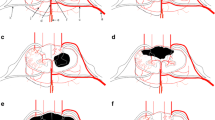Abstract
Dissection refers to a tear in the wall of an artery, with the two main types being intracranial or extracranial. Dissections tend to occur most commonly in the young, sometimes secondary to trauma involving the neck. To confirm a dissection, some type of vessel imaging is necessary, including magnetic resonance angiography (MRA), computed tomography angiography (CTA), or angiography. The most common presentation of a dissection (especially extracranial) is pain, usually head and neck pain along with a Horner’s syndrome. Patients may also present with ischemic symptoms, including transient ischemic attack (TIA) or stroke, which may also be a complication of a dissection. Although headache is a common presentation, there is little research into phenotype or long-term outcomes. There are a number of case reports detailing the phenotypes of headaches that may be present in dissection, including a migraine-like or hemicrania-like headache. Dissections are usually treated with some type of anti-platelet or anti-coagulation, although there are only a few randomized controlled trials. In a new acute headache, dissection is an important diagnosis to keep in mind.
Similar content being viewed by others
References
Papers of particular interest, published recently, have been highlighted as: • Of importance •• Of major importance
Debette S. Pathophysiology and risk factors of cervical artery dissection: what have we learnt from large hospital-based cohorts? Curr Opin Neurol. 2014;27:20–8.
Fisher CM. The headache and pain of spontaneous carotid artery dissection. Headache. 1982;22:60–5. Most prominent research on topic of this article.
Schievink WI, Roiter V. Epidemiology of cervical artery dissection. Front Neurol Neurosci. 2005;20:12–5.
Debette S et al. Epidemiology, pathophysiology, diagnosis and management of intracranial artery dissection. Lancet Neurol. 2015;14:640–54.
Nagumo K et al. Spontaneous intracranial internal carotid artery dissection: 6 case reports and a review of 39 cases in the literature. Rinsho Shinkeigaku. 2003;43(6):313–21.
Lee VH et al. Incidence and outcome of cervical artery dissection: a population-based study. Neurology. 2006;67:1809–12.
Arnold M et al. Vertebral artery dissection: presenting findings and predictors of outcome. Stroke. 2006;37(10):2499–503.
Biller J et al. Cervicocephalic arterial dissections. A ten year experience. Arch Neurol. 1986;43(12):1234–8.
Fusco MR, Harrigan MR. Cerebrovascular dissections—a review part I: spontaneous dissections. Neurosurgery. 2011;68:242–57.
Metso TM et al. Symptomatic recurrence of intracranial arterial dissections: follow-up study of 143 consecutive cases and pathological investigation. Stroke. 2013;44:126–31.
Mizutani T. Natural course of intracranial arterial dissections. J Neurosurg. 2011;114:1037–44.
Kuhn J, Mueller W, Harzheim A, Bewermeyer H. Long-lasting, refractory headache after bilateral dissection of the internal carotid artery. Schmerz. 2006;20(6):527–30.
Silbert PL, Mokri B, Schievink WI. Headache and neck pain in spontaneous internal carotid and vertebral artery dissections. Neurology. 1995;45(8):1517–22.
Ashkenazi A et al. Hemicrania continua-like headache associated with internal carotid artery dissection may respond to indomethacin. Headache. 2007;47(1):127–30.
Jatuzis D, Valaikiene J. Migraine-like presentation of vertebral artery dissection after cervical manipulative therapy. Perspect Med. 2012;1:452–54.
Hart RG, Easton JD. Dissections of cervical and cerebral arteries. Neurol Clin. 1983;1(1):155–82.
Hosoya T et al. Clinical and neuroradiological features of intracranial vertebrobasilar artery dissection. Stroke. 1999;30(5):1083–90.
Nakamizo T, Koide T, Miyazaki H. Progressive intracranial vertebral artery dissection presenting with isolated trigeminal neuralgia-like facial pain. Case Rep Neurol Med. 2015;2015:4.
Biousse V et al. Ophthalmologic manifestations of internal carotid artery dissection. Am J Ophthalmol. 1998;126(4):565–77.
Baumgartner RW et al. Carotid dissection with and without ischemic events; local symptoms and cerebral artery findings. Neurology. 2001;57(5):827–32.
Houser OW et al. Spontaneous cervical cephalic arterial dissection and its residuum: angiographic spectrum. AJNR Am J Neuroradiol. 1984;5(1):27–34.
Schwaighofer BW et al. MR imaging of vertebrobasilar basilar disease. J Comput Assist Tomogr. 1990;14(6):895–904.
Taschner CA et al. Computed tomography angiography for the evaluation of carotid artery dissections. Handbook on Cerebral Artery Dissection. Front Neurol Neurosci. 2005;20:119–28.
Reeves AG, Swenson RS. Disorders of the Nervous System. 2008. http://www.dartmouth.edu/~dons/.
Biousse V et al. Time course of symptoms in extracranial carotid artery dissections. Stroke. 1995;26:235–9.
Kwon JY, Kim N-Y, Suh DC, Kang D-W, Kwon SU, Kim JS. Intracranial and extracranial arterial dissection presenting with ischemic stroke: lesion location and stroke mechanism. J Neurol Sci. 2015;358(1–2):371.
Ro A et al. Intracranial vertebral artery dissection resulting in fatal subarachnoid hemorrhage: clinical and histopathological investigations from a medicolegal perspective. J Neurosurg. 2009;110(5):948–54.
Lucas C et al. Stroke patterns of internal carotid artery dissections in 40 patients. Stroke. 1998;29:2646–48.
The CADISS Trial Investigators. Antiplatelet treatment compared with anticoagulation treatment for cervical artery dissection (CADISS): a randomised trial. Lancet Neurol. 2015;14:361–67.
Pham M et al. Endovascular stenting of extracranial carotid and vertebral artery dissections: a systematic review of the literature. Neurosurgery. 2010;68(4):856–66.
Xianjun H, Zhiming Z. A systematic review of endovascular management of internal carotid artery dissections. Interv Neurol. 2013;1(3–4):164–70.
Ono H et al. Symptomatic recurrence of intracranial arterial dissections: follow-up study of 143 consecutive cases and pathological investigation. Stroke. 2013;44(21):126–31.
Metso TM et al. Prognosis and safety of anticoagulation in intracranial artery dissections in adults. Stroke. 2007;38:1837–42.
Touze E, Gauvrit J-Y, Moulin T, Meder J-F, Bracard S, Mas J-L. Risk of stroke and recurrent dissection after a cervical artery dissection: a multicenter study. Neurology. 2003;61:1347–51.
Gonzalez-Portillo F, Bruno A, Biller J. Outcome of extracranial cervicocephalic arterial dissections: a follow-up study. Neurol Res. 2002;24(4):395–8.
Rao A et al. Long-term outcomes of internal carotid artery dissection. J Vasc Surg. 2011;54(2):370–75. Only research done on long term outcomes of headache.
Author information
Authors and Affiliations
Corresponding author
Ethics declarations
Conflict of Interest
Huma Sheikh declares personal fees from Neurology Advisor for submission articles unrelated to this article.
Human and Animal Rights and Informed Consent
This article does not contain any studies with human or animal subjects performed by the author.
Additional information
This article is part of the Topical Collection on Secondary Headache
Rights and permissions
About this article
Cite this article
Sheikh, H.U. Headache in Intracranial and Cervical Artery Dissections. Curr Pain Headache Rep 20, 8 (2016). https://doi.org/10.1007/s11916-016-0544-1
Published:
DOI: https://doi.org/10.1007/s11916-016-0544-1




